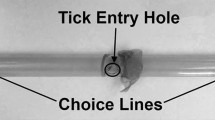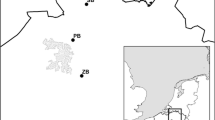Abstract
In investigations concerning the influence of stimuli emitted by chickens on the host-finding behaviour of hungry female adultArgas walkerae ticks, we found that 92.5% of the ticks migrated to the stimulus source following their simultaneous exposure to odours and to a CO2 gradient increasing in the direction of the chicken, as opposed to 67.5% following their exposure to kairomones of chickens in the absence of CO2. Migration of the ticks toward the stimulus source was precipitated by a wide range of CO2 concentrations (varying from 0.06 to 1 vol% within the odour mixture) but always required an increasing CO2 gradient in the direction of the chicken, whereby differences in concentration of 0.01 vol% over a distance of 2.5 cm were sufficient. During exclusive confrontation with either CO2 or heat in a gradient otherwise analogous to that emitted by a chicken, only 27.5% and 55% of the female ticks migrated to the stimulus source, respectively. Accordingly, odours emitted by chickens are considered to represent an essential stimulus modality, whereas body heat and CO2 are regarded merely as secondary, non-specific stimulatory agents. Investigations involving the exposure of ticks to a habitat similar to a chicken roost revealed that host seeking and finding are not influenced by gravity and occur only in darkness and that the portion of host-finding ticks diminishes with increasing distance from the blood donor.
Similar content being viewed by others

References
Gothe R, Neitz AWH (1985) An investigation into the emission sites of the volatile pheromone produced by females ofArgas (Persicargas) walkerae. Onderstepoort J Vet Res 52:31–33
Gothe R, Weck P, Kraiß A (1984) Zur pheromonal induzierten Kommunikation vonArgas (Persicargas) walkerae and biologisch-chemischen Bekämpfung durch kombinierten Einsatz eines Pheromons und Pheromon-Analogons mit Flumethrin. Zentralbl Veterinärmed [B] 31:161–179
Gothe R, Koch B, Leuterer G (1989) Zur Sensitivität vonArgas (Persicargas) walkerae auf optische Strahlung sowie zur Lokalisation und Organisation lichtperzipierender oder-durchlässiger Areale des Integumentes. Zentralbl Veterinärmed [B] 36:303–313
Hoogstraal H (1978) Biology of ticks. In: Wilde JKH (ed) Tickborne diseases and their vectors. Lewis Reprints, Tonbridge, pp 3–14
Leuterer G (1990) Zur Reaktivität und Reaktion adulterRhipicephalus eversi mimeticus undHyalomma truncatum auf optische Strahlung unterschiedlicher Wellenlängensektoren und Bestrahlungsstärken sowie eines sonnensimulierenden Spektralbereiches. Inaugural Dissertation, University of Munich
Neitz AWH, Gothe R (1984) Investigations into the volatility of female pheromones and the aggregation-inducing property of guanine inArgas (Persicargas) walkerae. Onderstepoort J Vet Res 51:197–201
Pfeifer R (1990) Zur Ökologie vonArgas (Persicargas) walkerae Kaiser and Hoogstraal, 1969. Inaugural Dissertation, University of Munich
Webb JP Jr, George JE, Cook B (1977) Sound as a host-detection cue for the soft tickOrnithodoros concanensis. Nature 265:443–444
Author information
Authors and Affiliations
Rights and permissions
About this article
Cite this article
Beelitz, P., Gothe, R. Investigations on the host seeking and finding ofArgas (Persicargas) walkerae (Ixodoidea: Argasidae). Parasitol Res 77, 622–628 (1991). https://doi.org/10.1007/BF00931026
Accepted:
Issue Date:
DOI: https://doi.org/10.1007/BF00931026



